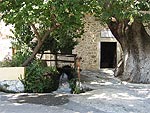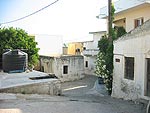 |
Zaros is situated at the foot
of the southern slopes of Psiloritis in the so-called Apano Riza area.
Apano Riza means "upper foot" and refers to the quite high
altitude of the area, 300-500 m above sea level. |
| The village is known for its
rich spring, Votomos, north of the village, supplying both the village and
the entire area with water through a developed web of channels, pipe
systems and water pipes. In the streets of the village you still see the
open watering channels, so that there is a delicious sound of running
water throughout the village even in the warmest summer months. |

|
 |
During the Roman period the
spring also supplied the then capital Gortyna in the Messara plain with
water as an aqueduct was built all the way from Zaros. |
| In addition to supplying Zaros
and the surrounding area with water for household and watering, the spring
also produces water for the factory of the village, which since 1988
fabricates bottled water for the whole of Greece - the well-known Zaros
Water. |

|
 |
On the outskirts of the village,
a lake has been constructed where the inhabitants of the village and
others may visit the surrounding restaurants, enjoying the coolness of the
water and the beautiful grounds. |
| The water is lead on to two
trout ponds, so even though the village is situated far away from the sea,
there is an excellent opportunity of having fish for dinner. |

|
|
|
|
| At one of the trout ponds a 400
years old watermill has been restored, so that the visitor can see how the
corn was milled in old times. The mill is owned by Michalis Frangiadakis
who tells us: |

|
 |
"My mill is 400 years old,
it is like an only child, because there is nothing similar on the whole
island. It belonged earlier to a Turkish family, but my father in law
bought it, and when I married his daughter I got the mill as a dowry.
Since then I have been there every single day. I learned the miller trade
and liked it. The mill has supported my whole family for many years..." |
|
|
|
| If you feel like a drop of cold
clear spring water, several wells have been built along the main street
and in the side streets where you may quench your thirst with the running
water. |

|
|
|
|
|
|
 |

|

|
|
|
|
|
|
 |

|

|
|
|
|
|
|
 |
North of the village at the
entrance of the Rouvas gorge, is the well-kept Agios Nikolaos monastery.
The monastery was deserted for a number of years, until it was restored
and came into use again when a couple of monks moved in. |
|
|
|
| High up on the
mountain-side east of the monastery you catch a glimpse of a church, built
at the St. Efthymios cave.
Efthymios lived here in isolation from other people and appeared only at
nightfall to gather berries and roots. On a dark evening the nuns from the
convent saw the shadow of a wild animal, which they shot. At dawn they had
to acknowledge that it was not an animal they had killed, but on the
contrary the hermit whom they of course had never seen.
|

|
| Today the
hermit is being worshipped as a saint. |
|
|
|
|






